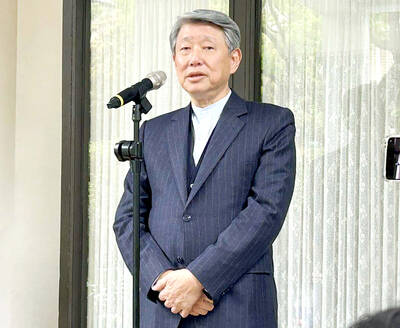Taiwan Semiconductor Manufacturing Co (TSMC, 台積電), the world’s largest contract chipmaker, yesterday said the Internet of Things (IoT) would be the industry’s major growth driver in the next three to five years.
The uptake of the IoT, including wearable devices, would spur demand for key components such as microcontrollers, image sensors and Wi-Fi and Bluetooth sensors, said John Wei (尉濟時), a senior director of TSMC’s mobile and computing business division.
“Those components will not entirely be made at 8-inch factories. Many of them, such as Wi-Fi and Bluetooth [sensors], are produced at 12-inch factories… The demand will be diverse from low-end [chips] to high-end [chips],” Wei told reporters on the sidelines of a press conference for the annual SEMICON exhibition in Taipei.
Wei said the IoT would not represent significant shipments in the near term, but it would be a big growth engine for the semiconductor industry in next three to five years, when the whole ecosystem and business model matured.
TSMC would be ready with the technologies needed, from power management ICs to application processors, he said.
Wei’s comments echoed TSMC chairman Morris Chang’s (張忠謀) speech on the “Next Big Thing” in March, when he said the IoT would be the industry’s new growth driver, taking over mobile devices such as smartphones and tablets.
SEMI Taiwan president Terry Tsao (曹世綸) yesterday said that the global semiconductor equipment market is expected to expand at a rate of 20.8 percent this year to US$38.4 billion and would grow about 11 percent year-on-year to US$42.6 billion next year, with Taiwan being the top consumer.
Tsao attributed the growth to new investment in IoT technologies.
Separately, equipment maker ASML Holding NV said its customers using advanced extreme ultraviolet (EUV) lithography would mass produce wafers by the end of 2016.
“We have made some progress. And we believe the EUV system will allow our customers to save manufacturing costs effectively,” ASML Taiwan director of technical marketing Peter Cheng (鄭國偉) said on the sidelines of the SEMICON press conference.
“More than one customer have had their EUV lithography machines reach a throughput of 500 wafers per day,” Cheng said.
The daily throughput is expected to increase to 15,000 wafers a day by 2016, based on the company’s roadmap, Cheng said.
Early last month, ASML confirmed that IBM Corp marked an EUV throughput record by producing 637 wafers a day.
EUV is the leading candidate for printing fine patterns for next-generation chips.
TSMC was not certain whether it would start using the EUV system to manufacture chips on 10-nanometer (nm) or 7-nanometer process technologies. TSMC is scheduled to start mass production of 10nm chips in 2017.
SEMI Taiwan said the annual trade show has attracted 650 companies around the world to showcase their latest products at the three-day exhibition, up from last year’s 586 companies.
Shanghai Integrated Circuit Industry Association consultant Xue Zi (薛自) said 13 of its members, including semiconductor equipment supplier North Microelectronics (北方微電子), would attend the show.
The number has doubled from last year, when the association’s members joined the show for the first time, Xue said.

MULTIFACETED: A task force has analyzed possible scenarios and created responses to assist domestic industries in dealing with US tariffs, the economics minister said The Executive Yuan is tomorrow to announce countermeasures to US President Donald Trump’s planned reciprocal tariffs, although the details of the plan would not be made public until Monday next week, Minister of Economic Affairs J.W. Kuo (郭智輝) said yesterday. The Cabinet established an economic and trade task force in November last year to deal with US trade and tariff related issues, Kuo told reporters outside the legislature in Taipei. The task force has been analyzing and evaluating all kinds of scenarios to identify suitable responses and determine how best to assist domestic industries in managing the effects of Trump’s tariffs, he

TIGHT-LIPPED: UMC said it had no merger plans at the moment, after Nikkei Asia reported that the firm and GlobalFoundries were considering restarting merger talks United Microelectronics Corp (UMC, 聯電), the world’s No. 4 contract chipmaker, yesterday launched a new US$5 billion 12-inch chip factory in Singapore as part of its latest effort to diversify its manufacturing footprint amid growing geopolitical risks. The new factory, adjacent to UMC’s existing Singapore fab in the Pasir Res Wafer Fab Park, is scheduled to enter volume production next year, utilizing mature 22-nanometer and 28-nanometer process technologies, UMC said in a statement. The company plans to invest US$5 billion during the first phase of the new fab, which would have an installed capacity of 30,000 12-inch wafers per month, it said. The

Taiwan’s official purchasing managers’ index (PMI) last month rose 0.2 percentage points to 54.2, in a second consecutive month of expansion, thanks to front-loading demand intended to avoid potential US tariff hikes, the Chung-Hua Institution for Economic Research (CIER, 中華經濟研究院) said yesterday. While short-term demand appeared robust, uncertainties rose due to US President Donald Trump’s unpredictable trade policy, CIER president Lien Hsien-ming (連賢明) told a news conference in Taipei. Taiwan’s economy this year would be characterized by high-level fluctuations and the volatility would be wilder than most expect, Lien said Demand for electronics, particularly semiconductors, continues to benefit from US technology giants’ effort

‘SWASTICAR’: Tesla CEO Elon Musk’s close association with Donald Trump has prompted opponents to brand him a ‘Nazi’ and resulted in a dramatic drop in sales Demonstrators descended on Tesla Inc dealerships across the US, and in Europe and Canada on Saturday to protest company chief Elon Musk, who has amassed extraordinary power as a top adviser to US President Donald Trump. Waving signs with messages such as “Musk is stealing our money” and “Reclaim our country,” the protests largely took place peacefully following fiery episodes of vandalism on Tesla vehicles, dealerships and other facilities in recent weeks that US officials have denounced as terrorism. Hundreds rallied on Saturday outside the Tesla dealership in Manhattan. Some blasted Musk, the world’s richest man, while others demanded the shuttering of his